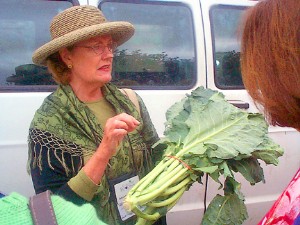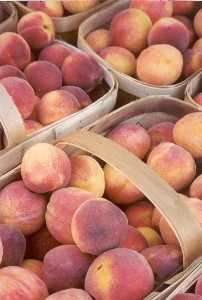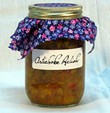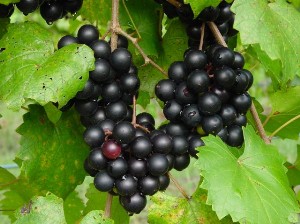Special Feature: Products Sally Recommends
Taking Comfort in Heritage Foods
 Some rituals of childhood are easy to remember. It seems like only yesterday that I dashed up the wisteria-lined lane at my Grandmother’s house carefully avoiding the drunken bumblebees darting across my path. I scurried on, eagerly anticipating the Sunday dinner that would soon be enjoyed. As I close my eyes now, my senses are flooded with the aromas, the sounds, and the tastes of those Sunday dinners. My heart embraces the memory of the warmth and love experienced in my Grandmother’s kitchen. During the most formative years of my life, there was no place I would rather be. As a tribute to the woman and her kitchen, my sister once told our mother “even a slice of bread tastes better at Grandmama’s house.”
Some rituals of childhood are easy to remember. It seems like only yesterday that I dashed up the wisteria-lined lane at my Grandmother’s house carefully avoiding the drunken bumblebees darting across my path. I scurried on, eagerly anticipating the Sunday dinner that would soon be enjoyed. As I close my eyes now, my senses are flooded with the aromas, the sounds, and the tastes of those Sunday dinners. My heart embraces the memory of the warmth and love experienced in my Grandmother’s kitchen. During the most formative years of my life, there was no place I would rather be. As a tribute to the woman and her kitchen, my sister once told our mother “even a slice of bread tastes better at Grandmama’s house.”
There is no doubt that the success of Grandmother’s cooking was in large part due to the love she added to her dishes. The country ham was baked to perfection with pineapple and cloves creating juices sweet and fragrant. A simmering pot of greens tapped out its own melody on the old white stove as the pungent odor drifted through the house. Hot and flaky scratch biscuits cradled homemade butter as it seeped through to every layer. The word delicious barely describes the foods that I learned to love at these dinners – macaroni pie, butter beans, fried chicken, rice and gravy, pilaus, sweet potatoes, sliced tomatoes fresh from the garden, corn pudding, grits, venison roast, catfish stew, smothered quail, artichoke relish, scuppernong preserves, lemon jelly cake, ambrosia, pecan pie and a host of others.
 Most of all, Sunday dinners at my Grandmother’s table were about family, tradition, and a sense of place. When I prepare these same foods today I am instantly connected to generations of my family. The recipes and techniques used by my Grandmother had their genesis in the cookery of South Carolina’s earliest settlers. I find that very comforting.
Most of all, Sunday dinners at my Grandmother’s table were about family, tradition, and a sense of place. When I prepare these same foods today I am instantly connected to generations of my family. The recipes and techniques used by my Grandmother had their genesis in the cookery of South Carolina’s earliest settlers. I find that very comforting.
South Carolina claims a rich heritage of foodways learned from the Native Americans, the enslaved Africans and the European settlers. Africans, who were brought as slaves to the colony, made enormous contributions to the culinary traditions developed here. The earliest colonists found a bounty of foods in their new land including peaches, figs, muscadines, pumpkins, squash, fish, nuts, corn and North American game. The settlers brought dairy cattle, swine, and chickens. Slave traders brought okra, field peas, eggplant, peanuts, and yams from Africa. The melding of foods, herbs, spices, and cooking techniques of the diverse cultures formed the foundation for our culinary traditions.
Taking a journey through the history of some of our favorite foods is an enlightening and entertaining experience. Okra, for example, has been a valued and versatile vegetable in South Carolina kitchens since Colonial times. Culinary historians believe it to be native to Africa and brought by African slaves to South Carolina in the 17 th century. It was originally used in pilaus (pronounced “pur-low”, this dish is a blend of rice cooked in one pot with other ingredients such as chicken, shrimp, or tomatoes), gumbos, soups, and stews. During the War Between the States, okra was used as one of many coffee substitutes. The seeds, when mature and slightly roasted, were an acceptable substitute for real coffee, which was nearly impossible to obtain because of Northern shipping blockades. Today, okra is enjoyed fried, boiled, scrambled, with tomatoes and corn, as a staple in vegetable soup, or crisply pickled.
 Summer would not be summer without peaches. The Spaniards brought peaches to North America in the 1500’s and records show that peaches were “discovered” in South Carolina in the early 1600’s. Colonists, upon arrival, immediately began to enjoy the delicious fruit. Recipes for peach sherbet, peach marmalade, peach leather, pickled peaches, preserved peaches, brandy peaches, and peach chips can be found in several of the earliest cookbooks of South Carolina. Today, South Carolina is known as “The Tastier Peach State” and is the second largest producer of peaches in the United States (with California being the first). During peach season, cooks across the State frequent farmer’s markets, roadside stands, orchards and packing sheds to buy the fruit at its peak ripeness. From this fragrant, sweet fruit, they make peach jam, pickled peaches, cobblers, pies, and ice cream.
Summer would not be summer without peaches. The Spaniards brought peaches to North America in the 1500’s and records show that peaches were “discovered” in South Carolina in the early 1600’s. Colonists, upon arrival, immediately began to enjoy the delicious fruit. Recipes for peach sherbet, peach marmalade, peach leather, pickled peaches, preserved peaches, brandy peaches, and peach chips can be found in several of the earliest cookbooks of South Carolina. Today, South Carolina is known as “The Tastier Peach State” and is the second largest producer of peaches in the United States (with California being the first). During peach season, cooks across the State frequent farmer’s markets, roadside stands, orchards and packing sheds to buy the fruit at its peak ripeness. From this fragrant, sweet fruit, they make peach jam, pickled peaches, cobblers, pies, and ice cream.
 Mention artichoke relish and newcomers to South Carolina wonder how in the world relish is made from those prickly globes. What they don’t know is that our favorite condiment is made from the Jerusalem artichoke. This artichoke is native to North America and grew wild along the eastern seaboard from Georgia to Nova Scotia. Often called a “sunchoke”, it is a relative of the sunflower. Native Americans ate the crunchy tubers and South Carolinians, for generations, have prized it as the main ingredient in special condiments such as artichoke relish and artichoke pickles. The Carolina Housewife by a Lady of Charleston, a cookbook published in 1847, contains instructions for pickling artichokes.
Mention artichoke relish and newcomers to South Carolina wonder how in the world relish is made from those prickly globes. What they don’t know is that our favorite condiment is made from the Jerusalem artichoke. This artichoke is native to North America and grew wild along the eastern seaboard from Georgia to Nova Scotia. Often called a “sunchoke”, it is a relative of the sunflower. Native Americans ate the crunchy tubers and South Carolinians, for generations, have prized it as the main ingredient in special condiments such as artichoke relish and artichoke pickles. The Carolina Housewife by a Lady of Charleston, a cookbook published in 1847, contains instructions for pickling artichokes.
No Thanksgiving dinner is complete without a dish of sweet potatoes. This tuber was cultivated in South Carolina before colonization. In Colonial days, sweet potatoes were so prized that they became an item of trade. During the Revolutionary and Civil Wars it was a staple food. A popular legend describes how Francis Marion, known as the Swamp Fox during the American Revolution, met with a British officer to discuss an exchange of prisoners. Following the negotiations, General Marion invited his guest for dinner. The menu consisted solely of sweet potatoes and water. The British officer was appalled and impressed at the same time. He reported, “I have seen an American general and his officers, without pay, and almost without clothes, living on roots and drinking water; and all for LIBERTY! What chance have we against such men?” Whether served baked, stewed, in pies, pones, in butters, or in soufflés, sweet potatoes have nourished generations of South Carolinians.
 Few who have breathed in the fruity, musky odor of Muscadine grapes will ever forget it. Muscadines are native to the Southeastern United States and were found growing wild by the early colonists. Their sweet juice and chewy pulp have made them a favorite fruit of Southerners ever since. Native Americans preserved muscadines as dried fruit long before the Europeans arrived on this continent. Muscadines do not grow in tight bunches but in clusters of four or more fruits which, when ripe, allows them to be harvested easily by shaking the vine. Muscadines, with their unique flavor have been used to make jams and wine since the seventeenth century. They are still used today in much the same way. The Scuppernong variety of the muscadine grape has a tough, bronzy green skin, is about 1-½ inches in diameter, and has been best described by local farmers as "about the size of a hog's eye". The early colonists first discovered Scuppernongs growing on the coasts of Georgia and South Carolina. They were originally called simply “the big white grape”.
Few who have breathed in the fruity, musky odor of Muscadine grapes will ever forget it. Muscadines are native to the Southeastern United States and were found growing wild by the early colonists. Their sweet juice and chewy pulp have made them a favorite fruit of Southerners ever since. Native Americans preserved muscadines as dried fruit long before the Europeans arrived on this continent. Muscadines do not grow in tight bunches but in clusters of four or more fruits which, when ripe, allows them to be harvested easily by shaking the vine. Muscadines, with their unique flavor have been used to make jams and wine since the seventeenth century. They are still used today in much the same way. The Scuppernong variety of the muscadine grape has a tough, bronzy green skin, is about 1-½ inches in diameter, and has been best described by local farmers as "about the size of a hog's eye". The early colonists first discovered Scuppernongs growing on the coasts of Georgia and South Carolina. They were originally called simply “the big white grape”.
Knowing more about food traditions helps us to reconnect with our heritage and, in turn, to pass along the traditions to our children and grandchildren. As Daniel Webster once said, “ Those who do not look upon themselves as a link connecting the past with the future do not perform their duty to the world.”
RECIPES
An 1800’s version of Macaroni Pie from The Carolina Housewife by a Lady of Charleston, published in 1847:
To Dress Macaroni A La Sauce Blanche
Take a quarter of a pound of macaroni; boil it in water, in which there must be a little salt. When the macaroni is done, the water must be drained from it, and the saucepan kept covered; roll two table-spoon-fuls of butter in a little flour; take a pint of milk, and half a pint of cream; add the butter and flour to the milk, and set it on the fire, until it becomes thick. This sauce ought to be stirred the whole time it is boiling, and always in the same direction. Grate a quarter of a pound of parmesan cheese; butter the pan in which the macaroni is to be baked, and put in first a layer of macaroni, then one of grated cheese, them some sauce, and so on until the dish is filled. The last layer must be of cheese, and sauce with which the macaroni is to be well covered. Ten minutes will bake it in a quick oven.
My Grandmother’s Macaroni Pie recipe:
Macaroni Pie
½ pound macaroni
1 ½ cups extra sharp cheddar cheese
2 tablespoons butter
1 ½ cups milk
2 eggs, well beaten
½ teaspoon salt
¼ teaspoon pepper
Boil the macaroni in salted water until tender. Drain; place in greased casserole dish. Stir in butter and cheese, reserving ¼ cup of cheese. Add milk, eggs, and seasonings. Stir until blended. Sprinkle remaining cheese on top and dot with butter. Bake at 350° for approximately 30 minutes until pie is congealed but not dry.
Serves 6
![]()
Note: This information was accurate when it was published. Please be sure to confirm all rates and details directly with the businesses in question before making your plans.



